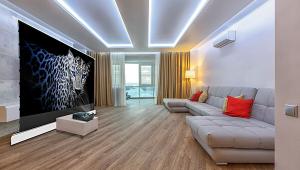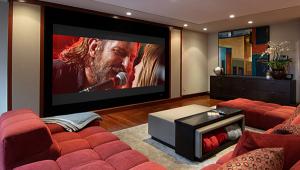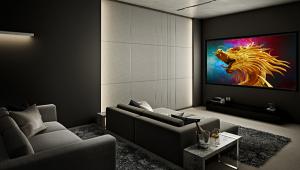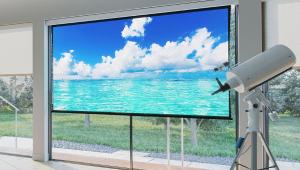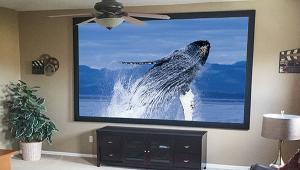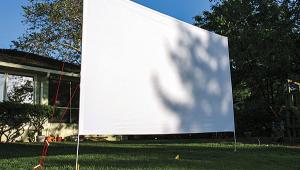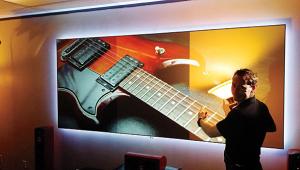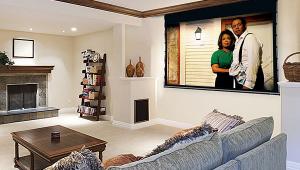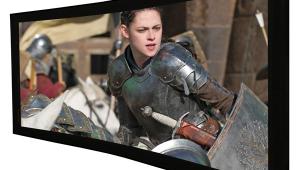Screen Innovations Slate Projection Screen Page 2
Next I set up two table lamps, each with a 50- or 60-watt bulb and a brown shade, with one lamp on each side of the screen. As long as the lamps were roughly midway between the screen and the projector, and far enough off to the side so as not to fool the screen into treating them as part of the projector’s output, the result was satisfactory. Satisfactory, that is, in that bright images—such as sports programs and animated films—were quite watchable.
Live-action movies, however, were another matter. Bright scenes were effective, and though they weren’t quite the equal of the same scenes with the lights off, many viewers won’t notice the difference, or at least won’t be bothered by it. But dark scenes, at least with my JVC DLA-X55 test projector, were washed out in a way that everyone will notice (though viewers unfamiliar with how much better those scenes look in the dark may not care). Was the Slate superior in this respect to a conventional white screen with equivalent gain? Yes. When I held a sample of Stewart’s StudioTek 130 next to the Slate during a dark scene from Pompeii (a movie dominated by dark scenes), the SI screen easily won—though neither screen was close to being a contrast and black-level champ with such scenes and the lights on. (To be fair, the JVC we had on hand, while capable of delivering deep blacks, is hardly the brightest projector out there for testing a light-rejecting screen; SI would have preferred an Epson or other high-output model.)
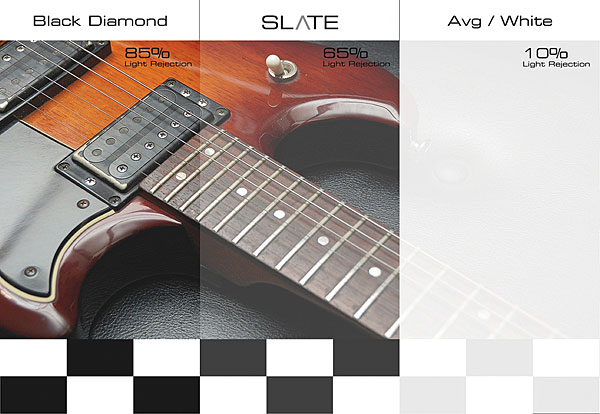
When I shut the lights off, the Slate turned into an excellent screen for all source material. Yes, its off-angle, light-rejecting characteristics (which give it the ability to tolerate at least some room lighting) resulted in a picture that was brighter on the near side (when you’re seated off center) than on the far side in comparison to a screen like the StudioTek (see Test Bench). But this effect was no worse than what I’ve seen on many gray screens over the years and is unlikely to be visible on most scenes to most viewers. In the dark, the Slate made full use of the detail, rich color saturation, and contrast available from the JVC.
Conclusions
There is, as yet, no such thing as a front-projection screen that will provide the same performance in a well-lit room—in any possible way for all sorts of program material—as it will in a fully darkened room. That’s a fact of life in the projection business. If there is such a screen, we haven’t seen it.
Consider the possible viewing environments of any home theater. There may be a wall of uncovered windows facing south at noon in July. Or a few table lamps. Or some overhead spot lamps aimed so they don’t strike the screen directly or produce significant room reflections that might strike the screen. Given that wide range of environments, only a test in your own room can tell you if a screen like the Slate will help in your situation. Just don’t expect to see the sort of bright, rich projected image often found in glossy shots of fully lit home theaters. (Yes, including the shots that accompany our reviews. These publicity photos have to show both a lit room and a projected image, and don’t reflect the real world.)
Such a home test may be the only way to truly judge how you’ll like the results from such a screen in your own room under the sort of lighting most likely to be used for serious viewing. This will, of course, require either a very cooperative dealer who can set up the screen in your home for a yea or nay decision, or a large enough sample of the screen material to help you decide.
Screens such as SI’s Black Diamond and Slate serve an important need. While most obsessive video perfectionists (yours truly included) will continue to use a projector in a fully darkened room, not every big-screen fan is prepared to make that compromise. At least, not every day.
